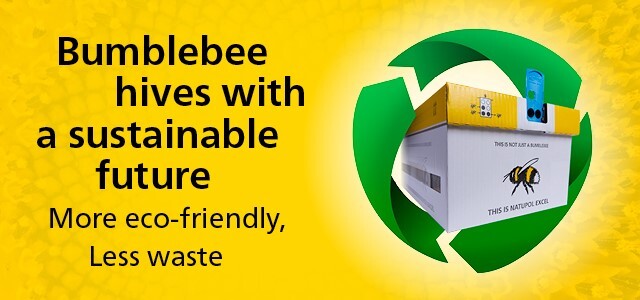
Working sustainably in partnership with nature, we have developed a bumblebee hive for crop pollination that reduces the CO2 footprint of the hive by 52% by using 85% recycled or renewable materials.
With sustainability and working in partnership with nature high on the agenda since our inception, we have been producing bumblebee hives for horticulture and agriculture for more than 30 years. The latest improvements to the hive is that it is mostly produced with renewable or recycled materials. The cardboard used for the Natupol range has been made from recycled paper for some years now. More recently, the plastic components of the hive, such as the ‘bee home’ door and the inner lining of the hive have been produced from 100% post-consumer recycled plastic waste. The printing ink used on the exterior of the packaging is free of heavy metal substances.
Sustainable steps taken
The post-consumer recycled plastic used for the Natupol hives is of a high-quality grade and has been thoroughly tested to secure both functionality of the product and the needs of the bumblebees. Our supplier declares that it “lowers the carbon footprint by 52%, compared to traditional, virgin plastic polymers.” This new product update is the next step towards a 100% eco-friendly hive.
‘It brings us a few steps closer to our mission to replace non-renewable plastics with eco-friendly materials and reduce the amount of waste issues for growers,’ says Natupol Product Manager, Remco Huvermann. ‘The Natupol range is under continuous scrutiny and the new sustainable hives represent 3 years of research and development. At Koppert, we won’t stop our on-going sustainability upgrades.’
Low environmental impact
In anticipation of national and international sustainability legislation, such as the EU waste legislation* that came into effect on 4 March 2019, steps have been made to reduce the impact Natupol hives may have on the environment. Continuous R&D innovation to reduce our ecological footprint and a growing demand for more sustainable hives from our growers themselves, have resulted in hives that are now more eco-friendly.
The Natupol hives were amongst the first to be introduced into greenhouses in the 90s and served as ‘ambassadors’ for the biological control of crops as they ensured that no chemical agents could be used while the bumblebees did their vital pollinating work. Growers using Natupol hives soon turned to biological solutions to control pests and diseases, and took decisive steps to keep their produce free of chemical residues. The new eco-friendly hives reflect our ongoing mission for 100% sustainable horticulture and agriculture.
‘We believe that we can find solutions for the challenges of the future and provide food security by working sustainably in partnership with nature,’ Huvermann concludes.
* https://ec.europa.eu/environment/topics/circular-economy/first-circular-economy-action-plan_nl